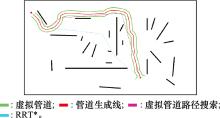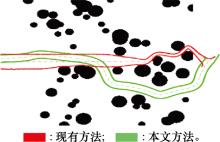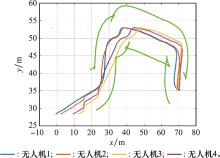Systems Engineering and Electronics ›› 2024, Vol. 46 ›› Issue (10): 3528-3535.doi: 10.12305/j.issn.1001-506X.2024.10.29
• Guidance, Navigation and Control • Previous Articles
Space satisfaction planning for curved virtual tube of unmanned aerial vehicle swarm
Shibo XIAO1, Guoyuan QI1,*, Jiahao DENG1, Pengpeng SU1, Jingtong JIA2
- 1. School of Control Science and Engineering, Tiangong University, Tianjin 300387, China
2. School of Electronics and Information Engineering, Tiangong University, Tianjin 300387, China
-
Received:2023-07-14Online:2024-09-25Published:2024-10-22 -
Contact:Guoyuan QI
CLC Number:
Cite this article
Shibo XIAO, Guoyuan QI, Jiahao DENG, Pengpeng SU, Jingtong JIA. Space satisfaction planning for curved virtual tube of unmanned aerial vehicle swarm[J]. Systems Engineering and Electronics, 2024, 46(10): 3528-3535.
share this article
| 1 | 齐小刚, 周雨桐, 刘立芳. 无人机集群对地作战任务可靠性评估[J]. 系统工程与电子技术, 2023, 45 (9): 2971- 2978. |
| QI X G , ZHOU Y T , LIU L F . Evaluation of the reliability of UAV swarm for ground combat missions[J]. Systems Engineering and Electronics, 2023, 45 (9): 2971- 2978. | |
| 2 | 张洪海, 任真苹, 冯讴歌, 等. 城市低空物流无人机飞行计划预先调配[J]. 系统工程与电子技术, 2023, 45 (9): 2802- 2811. |
| ZHANG H H , REN Z P , FENG O G , et al. Logistics unmanned aerial vehicle flight plan pre-allocation in urban low-altitude airspace[J]. Systems Engineering and Electronics, 2023, 45 (9): 2802- 2811. | |
| 3 | 王宁, 李哲, 梁晓龙, 等. 通信距离受限条件下的无人机集群协同区域搜索[J]. 系统工程与电子技术, 2022, 44 (5): 1615- 1625. |
| WANG N , LI Z , LIANG X L , et al. Cooperative region search of UAV swarm with limited communication distance[J]. Systems Engineering and Electronics, 2022, 44 (5): 1615- 1625. | |
| 4 |
CHUNG S J , PARANJAPE A A , DAMES P , et al. A survey on aerial swarm robotics[J]. IEEE Trans.on Robotics, 2018, 34 (4): 837- 855.
doi: 10.1109/TRO.2018.2857475 |
| 5 | MIAO Z, THAKUR D, ERWIN R S, et al. Orthogonal vector field-based control for a multi-robot system circumnavigating a moving target in 3D[C]//Proc. of the IEEE 55th Conference on Decision and Control, 2016: 6004-6009. |
| 6 |
WANG L , AMES A D , EGERSTEDT M . Safety barrier certificates for collisions-free multirobot systems[J]. IEEE Trans.on Robotics, 2017, 33 (3): 661- 674.
doi: 10.1109/TRO.2017.2659727 |
| 7 |
VASARHELYI G , VIRAGH C , SOMORJAI G , et al. Optimized flocking of autonomous drones in confined environments[J]. Science Robotics, 2018, 3 (20): eaat3536.
doi: 10.1126/scirobotics.aat3536 |
| 8 | QUAN Q , FU R , LI M X , et al. Practical distributed control for VTOL UAVs to pass a virtual tube[J]. IEEE Trans.on Intelligent Vehicles, 2021, 7 (2): 342- 353. |
| 9 | GAO Y , BAI C G , QUAN Q . Distributed control for a multi-agent system to pass through a connected quadrangle virtual tube[J]. IEEE Trans.on Control of Network Systems, 2022, 10 (2): 693- 705. |
| 10 |
QUAN Q , GAO Y , BAI C G . Distributed control for a robotic swarm to pass through a curve virtual tube[J]. Robotics and Autonomous Systems, 2023, 162, 104368.
doi: 10.1016/j.robot.2023.104368 |
| 11 | MAO P D, QUAN Q. Making robotics swarm flow more smoothly: a regular virtual tube model[C]//Proc. of the IEEE/RSJ International Conference on Intelligent Robots and Systems, 2022: 4498-4504. |
| 12 | TSENG F H, LIANG T T, LEE C H, et al. A star search algorithm for civil UAV path planning with 3G communication[C]// Proc. of the IEEE 10th International Conference on Intelligent Information Hiding and Multimedia Signal Processing, 2014: 942-945. |
| 13 | KARAMAN S, WALTER M R, PEREZ A, et al. Anytime motion planning using the RRT[C]// Proc. of the IEEE International Conference on Robotics and Automation, 2011: 1478-1483. |
| 14 | MELLINGER D, KUMAR V. Minimum snap trajectory generation and control for quadrotors[C]//Proc. of the IEEE International Conference on Robotics and Automation, 2011: 2520-2525. |
| 15 | RICHTER C, BRY A, ROY N. Polynomial trajectory planning for aggressive quadrotor flight in dense indoor environments[C]// Proc. of the 16th International Symposium for Robotics Research, 2016: 649-666. |
| 16 |
LIU S , WATTERSON M , MOHTA K , et al. Planning dynamically feasible trajectories for quadrotors using safe flight corridors in 3-D complex environments[J]. IEEE Robotics and Automation Letters, 2017, 2 (3): 1688- 1695.
doi: 10.1109/LRA.2017.2663526 |
| 17 | PARK J , KIM H J . Online trajectory planning for multiple quadrotors in dynamic environments using relative safe flight corridor[J]. IEEE Robotics and Automation Letters, 2020, 6 (2): 659- 666. |
| 18 | GAO F, WU W, LIN Y, et al. Online safe trajectory generation for quadrotors using fast marching method and Bernstein basis polynomial[C]//Proc. of the IEEE International Confe-rence on Robotics and Automation, 2018: 344-351. |
| 19 |
ZHOU B Y , GAO F , WANG L Q , et al. Robust and efficient quadrotor trajectory generation for fast autonomous flight[J]. IEEE Robotics and Automation Letters, 2019, 4 (4): 3529- 3536.
doi: 10.1109/LRA.2019.2927938 |
| 20 | ZHOU X , WANG Z P , YE H K , et al. EGO-planner: an ESDF-free gradient-based local planner for quadrotors[J]. IEEE Robotics and Automation Letters, 2020, 6 (2): 478- 485. |
| 21 |
ZHOU B , PAN J , GAO F , et al. Raptor: robust and perception-aware trajectory replanning for quadrotor fast flight[J]. IEEE Trans.on Robotics, 2021, 37 (6): 1992- 2009.
doi: 10.1109/TRO.2021.3071527 |
| 22 |
GAO Y , BAI C G , ZHANG L , et al. Multi-UAV cooperative target encirclement within an annular virtual tube[J]. Aerospace Science and Technology, 2022, 128, 107800.
doi: 10.1016/j.ast.2022.107800 |
| 23 | FU R , QUAN Q , LI M X , et al. Practical distributed control for cooperative multicopters in structured free flight concepts[J]. IEEE Trans.on Intelligent Transportation Systems, 2022, 24 (4): 4203- 4216. |
| 24 |
MAO P D , FU R , QUAN Q . Optimal virtual tube planning and control for swarm robotics[J]. The International Journal of Robotics Research, 2024, 43 (5): 602- 627.
doi: 10.1177/02783649231210012 |
| 25 | LYU S L, GAO Y, CHE J X, et al. Autonomous drone racing: time-optimal spatial iterative learning control within a virtual tube[C]// Proc. of the IEEE International Conference on Robotics and Automation, 2023: 3197-3203. |
| 26 | 杨小草, 都延丽, 步雨浓, 等. 基于层次分解的在线三维RRT*协同航路规划[J]. 系统工程与电子技术, 2023, 45 (5): 1409- 1419. |
| YANG X C , DU Y L , BU Y N , et al. Online three-dimensional RRT*cooperative route planning based on hierarchical decomposition[J]. Systems Engineering and Electronics, 2023, 45 (5): 1409- 1419. | |
| 27 | 高升, 艾剑良, 王之豪. 混合种群RRT无人机航迹规划方法[J]. 系统工程与电子技术, 2020, 42 (1): 101- 107. |
| GAO S , AI J L , WANG Z H . Mixed population RRT algorithm for UAV path planning[J]. Systems Engineering and Electronics, 2020, 42 (1): 101- 107. | |
| 28 |
WANG Z P , ZHOU X , XU C , et al. Geometrically constrained trajectory optimization for multicopters[J]. IEEE Trans.on Robotics, 2022, 38 (5): 3259- 3278.
doi: 10.1109/TRO.2022.3160022 |
| 29 | QUINLAN S, KHATIB O. Elastic bands: connecting path planning and control[C]//Proc. of the IEEE International Conference on Robotics and Automation, 1993: 802-807. |
| 30 | WANG S, DAI X H, KE C X, et al. RflySim: a rapid multicopter development platform for education and research based on Pixhawk and Matlab[C]//Proc. of the IEEE International Conference on Unmanned Aircraft Systems, 2021: 1587-1594. |
| [1] | Cong LIU, Haifeng LI, Mingming WANG, Jianjun LUO. Robot motion planning method for space truss on-orbit assembly [J]. Systems Engineering and Electronics, 2024, 46(2): 715-721. |
| [2] | Baochen ZHANG, Jianjiang HUI, Qi ZHANG, Zhengxiong LIU, Panfeng HUANG. Touch interaction technology for obstacle avoidance motion planning of redundant manipulators [J]. Systems Engineering and Electronics, 2024, 46(1): 254-260. |
| [3] | Xun GONG, Yunbo FU, Liangxu JIANG, Ce CAO, Tongjian GUO. Application of super-twisting extended state observer in fault reconfiguration of quadrotor aircraft [J]. Systems Engineering and Electronics, 2020, 42(9): 2077-2084. |
| [4] | HE Youzhi, LIU Tongqi. Time delay integral backstepping based fault tolerant#br# control of quadrotor aircraft [J]. Systems Engineering and Electronics, 2015, 37(10): 2341-2346. |
| [5] | PENG Shuang-chun, SU Fei, PAN Liang, SHEN Lin-cheng. Motion planning for highaltitude highspeed aircraft based on dynamical symmetry [J]. Journal of Systems Engineering and Electronics, 2011, 33(7): 1534-1538. |
| Viewed | ||||||
|
Full text |
|
|||||
|
Abstract |
|
|||||



























